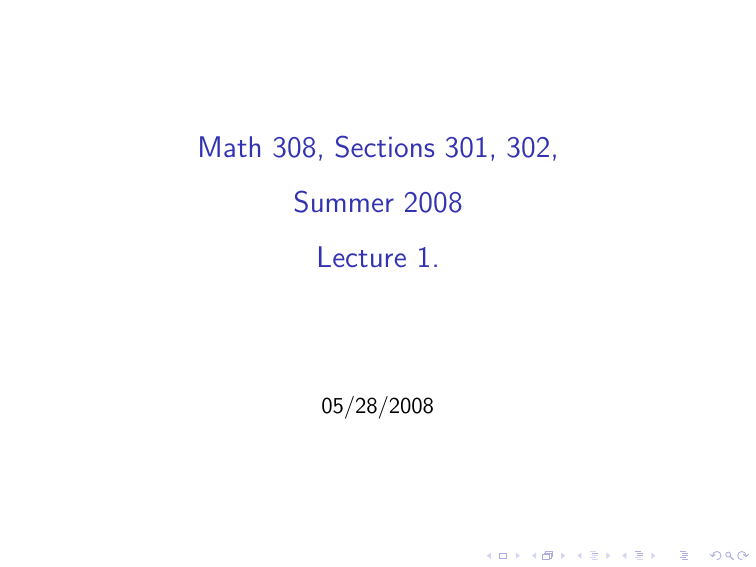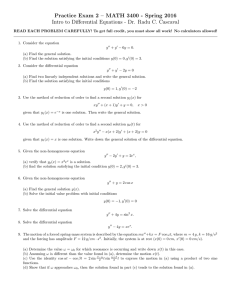Math 308, Sections 301, 302, Summer 2008 Lecture 1. 05/28/2008

Math 308, Sections 301, 302,
Summer 2008
Lecture 1.
05/28/2008
Chapter 1.
Introduction
Section 1.1.
Background
Definition.
Equation that contains some derivatives of an unknown function is called a differential equation .
Examples:
(a) In case of free fall, an object is released from a certain height above the ground and falls under the force of gravity (we are assuming here that gravity is the only force acting on the object an that force is a constant).
d 2 h dt 2
= − g
(b) In the case of radioactive decay, we begin from the premise that the rate of decay is proportional to the amount of radioactive substance present.
dA dt
= − kA , k > 0 , where A > 0 is the unknown amount of radioactive substance present at time t and k is a constant.
If an equation involves the derivative of one variable with respect to another, then the former is called a dependent variable and the latter is called an independent variable .
Definition.
A differential equation involving only ordinary derivatives with respect to a single variable is called an ordinary differential equations or ODE. A differential equation involving partial derivatives with respect to more then one variable is a partial differential equations or PDE.
Definition.
The order of a differential equation is the order of the highest-order derivatives present in equation.
Definition.
An ODE is linear if it has format a n
( x ) d n y dx n
+ a n − 1
( x ) d n −
1 y dx n − 1
+ a
1
( x ) dy dx
+ a
0
( x ) y = F ( x ) , where a n
( x ), a n −
1
( x ),..., a
0
( x ) and F ( x ) depend only on variable x .
If an ODE is not linear, then we call it nonlinear .
Example 1.
For each of the differential equations give its order and indicate the independent and dependent variables, and indicate whether it is linear or nonlinear.
(a) ln( x ) d 2 dx y
2
(b) 2 y ′′ − 3 y
2
+ 3 e x
= e x dy dx
− y sin x = 0
(c)
(d)
(e) d y y
3 y dx 3
′′
′′
+ ( x
2 − 1) y + cos
− sin ( x + y ) y ′
− e xy
= cos(2 x
+ (
+ y x
)
2 x = 0
+ 1) y = 0
Example 2.
Write a differential equation that fits the physical description.
The velocity at time t of a particle moving along a straight line is proportional to the fourth power of its position x .
Section 1.2.
Solutions and Initial Value Problems
A general form for an n th-order equation with variable x and unknown function y = y ( x ) can be expressed as
F x , y , dy dx
, · · · , d n y dx n
= 0 , (1) where F is a function that depends on x , y , and the derivatives of y up to the order n . We assume that the equation holds for all x in an open interval I ( a < x < b , where a or b could be infinite).
d n y dx n
= f x , y , dy dx
, · · · , d n − 1 y dx n −
1
= 0 .
(2)
Definition.
A function ϕ ( x ) that when substituted by y in
equation (1) or (2) satisfies the equation for all
x in the interval I is called an explicit solution to the equation on I .
Example 3.
Determine whether the function is an explicit solution to the given differential equation.
(a) ϕ ( x ) = 5 x
2 , xy ′ = 2 y ;
(b) ϕ ( x ) = C
1 cos 5 x + C
2 sin 5 x , y ′′ + 25 y = 0.
√
(c) ϕ ( x ) = 2 x − x 2 , y 3 y ′′ + 1 = 0.
Definition.
A relation G ( x , y ) = 0 is said to be an implicit solution
to equation (1) on the interval
I if it defines one or more explicit solutions on I .
Example 4.
Show that the relation x 2 − xy + y defines the solution to the equation ( x − 2 y ) y ′
2
= 2
= 1 implicitly x − y .
Example 5.
Show that y − ln y = x to the equation dy dx
=
2 xy y − 1
.
2 + 1 is an implicit solution
Example 6.
Verify that x 2 + Cy 2 = 1, where C is an arbitrary constant, is a one-parameter family of implicit solution to dy
= xy and graph several of the solution curves using the dx x 2 − 1 same coordinate axes.
2 y 1
K2 K1
K1
0 1 x
C=0 C=1
K2
C=-1 C=2 C=-2
Figure 1.
Implicit solutions x 2 + Cy 2 = 1
2
Definition.
By an initial value problem for an n th-order differential equation
F x , y , dy dx
, · · · , d n y dx n
= 0 we mean: Find a solution to the differential equation on an interval
I that satisfies at x
0 the n initial conditions: y ( x
0
) = y
0
, dy dx
( x
0
) = y
1
, ..., d n − 1 y dx n − 1
( x
0
) = y n − 1
, where x
0
∈ I and y
0
, y
1
,..., y n − 1 are given constants.
In case of a first-order equation F x , y , dy dx reduce to the single requirement
, the initial conditions y ( x
0
) = y
0
, and in the case of a second-order equation, the initial conditions have the form y ( x
0
) = y
0
, dy dx
( x
0
) = y
1
.
Example 7.
The function ϕ ( x ) = C
1 cos 5 x + C
2 sin 5 x is a solution to y ′′ + 25 y = 0 for any choice of the constants C
1 and
C
2
. Determine C
1 and C
2 so that the initial conditions y (0) = π a nd dy dx
(0) = 1 are satisfied.
Theorem 1.
Given the initial value problem dy dx
= f ( x , y ) , y ( x
0
) = y
0
, assume that f and ∂ f /∂ y are continuous functions in a rectangle
R = { ( x , y ) : a < x < b , c < y < d } that contains the point ( x
0
, y
0
). Then the initial value problem has a unique solution ϕ ( x ) in some interval x
0
− δ < x < x
0
+ δ , where
δ is a positive number.
This theorem tells us two things. First, when an equation satisfies the hypotheses of Theorem 1, we are assured that a solution to the initial problem exists. Second, when the hypotheses are satisfied, there is a unique solution to the initial value problem. Notice that theorem works only in some neighborhood ( x
0
− δ, x
0
+ δ )
Example 8.
For the initial value problem dy dx
= x
3
− y
3
, y (0) = 6 , does Theorem 1 imply the existence of a unique solution?
Example 9.
Does Theorem 1 imply the existence of a unique solution to the initial value problem y ′ = 3 x − p
3 y − 1 , y (2) = 1?



